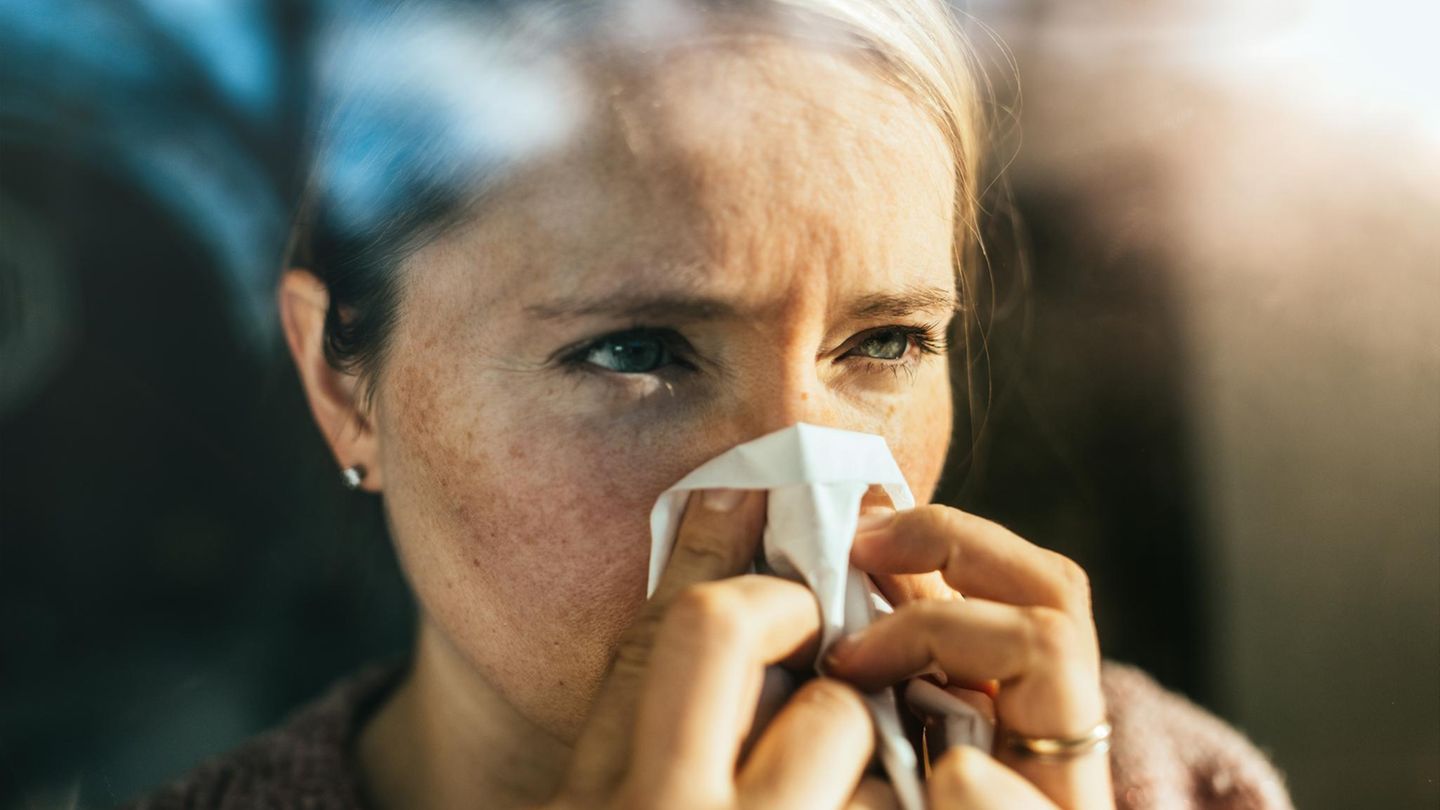Inflammation, allergy & co
Permanent runny nose: Why is my nose running all the time?
Copy the current link
Add to the memorial list
Guard sniffing is not an independent clinical picture, but a symptom with many causes. If you know this, you can specifically do something against the constantly running nose.
“Do you have a handkerchief?” I hear from my aunt very often. She is 71 and has been fighting with her permanently running nose for several years. When driving, walking with your dog or like today, with the weeds in the garden, a handkerchief must always be tangible. She therefore does not go to the doctor. “It’s not bad,” she says. Nevertheless, it is annoyed. As my aunt, many are: running sniffing is considered harmless and is rarely clarified by a doctor, although he can severely affect everyday life by those affected. But what is it actually behind? And what helps?
Flow sniffing: What is that anyway?
There is no such thing as a runny nose. The term only describes the symptom of a running nose (in the technical language rhinorrhea), in which the nasal mucosa increases increasingly aqueous secretion. Behind it can be a whole series of triggers, such as inflammation of the nasal mucosa (rhinitis), allergies, temperature changes, dry air, certain smells, side effects of medication or hormonal changes.
A distinction is made between rhinorrhea: inflammation of the nasal mucosa, in which other complaints often occur such as a constantly running nose, sneezing or a clogged nose. It can be allergic, non -allergic, medication, hormonal or infectious. “If the problems, such as a running nose, sneezing or a clogged nose, are spoken of chronic rhinitis,” explains Dr. Anna Sophie Hoffmann, specialist for ENT medicine from the University Hospital Hamburg-Eppendorf.
What are the most common causes?
In her medical practice, Hoffmann encounters three causes: allergic rhinitis, vasomotor rhinitis and rhinitis medicament.
- Allergic rhinitis is usually triggered by pollen or dust mites.
- Vasomotor rhinitis: Here the nasal mucosa reacts hypersensively to stimuli without an allergy or infection being present. The vessels widen and produce increasingly secretions. The trigger is common (cigarette) smoke, air conditioning systems, temperature changes, fragrances or exhaust gases.
- Rhinitis Medicamentosa: This form arises when you use decongestant nasal sprays for too long. In addition to a blocked nose or frequent sneezing, there can also be a permanently running nose.
Hormonal changes can also influence the mucous membranes and lead to a runny nose. Typical example: pregnancy and menopause. Thyroid diseases can also stick behind. In addition, medication for many people are the trigger, including blood pressure lowerers, pain relievers, antidepressants or hormonal preparations. “Such relationships are often overlooked because those affected do not connect the runny nose to their medication or hormonal situation,” says Hoffmann.
What is an “old stance nose”?
A special form of flow sniffing affects older people: the so -called age drop nose (chronically senile rhinitis). It arises from an age -related change in the mucous membrane. The nose then produces excessively aqueous secretion, often accompanied by crusts or constipation. Many of those affected therefore often consider the symptoms to be a cold, although there is no infection. The problems can be reinforced by external influences such as temperature changes or particularly spicy dishes. An old -age nose is harmless, but it remains annoying.
When should you go to the doctor?
An acute runny nose is usually unproblematic if it subsides after ten days at the latest. “A clarification is necessary if the symptoms exist for more than three to four weeks, repeatedly occur or do not respond to standard measures,” says Hoffmann. Standard measures are the usual therapy measures in runny nose, such as the short -term use of decongestant nasal sprays or nasal rinsing with saline solution.
Urgent warning signals are also when the flow sniff smells bad, secretion only comes out of a nostril when nose bleeding occurs or there are severe headaches and visual disturbances. “This could indicate the following serious illnesses: a sinus infection, a foreign body or in rare cases a so -called cuff thistle or a tumor. This should be clarified immediately,” advises Hoffmann.
How does a diagnosis work?
At the beginning, the duration and course of the symptoms, possible triggers and taken medication are queried. Allergies, previous illnesses and accompanying symptoms also play a role. This is usually followed by an examination using a nasal mirror (rhinoscopy). If necessary, the function tests of the nose, allergied diagnostics, blood tests or imaging methods such as computer tomography or magnetic resort are added. “Depending on the finding, we use further tests to determine the cause as precisely as possible,” explains Hoffmann.

What are the treatment options?
- Allergic rhinitis: cortisone -containing nasal sprays that appear locally and quickly relieve the symptoms. In addition, antihistamines can be used. It is important to avoid contact with the triggering allergens such as pollen or mites.
- Vasomotor rhinitis: Special anticholinergics in spray form can reduce secretion production. In some cases, capsaicin therapy is used, in which an active ingredient from chili pods calms hypersensitive nerves in the nose.
- Rhinitis Medicamentosa: Dulging nasal sprays have to be gradually discontinued, often in combination with cortisone -containing sprays.
- Hormonal causes: Complaints in pregnancy, menopause or in the case of thyroid diseases often improve when the hormone balance is stabilized or the underlying disease is treated.
- Medicinal runny nose: triggering medication such as blood pressure lowerers or hormonal preparations can be replaced by other active ingredients in consultation with doctors.
- Age drop nose: the focus is on mucosal care and symptom relief, for example with moisturizing nasal ointments or regular nasal showers.
“In rare cases, there is also a structural cause – such as a strong nasal septum curvature or a nasal mussel hyperplasia – the cause of permanent flow sniffing,” says Hoffmann. “Then surgery may be necessary.”
Is suffering curable?
In most cases, flow sniffing is easy to treat, especially when the cause is clarified. Not all forms are curable. It becomes difficult, for example, in chronic forms such as vasomotor rhinitis, which sometimes hardly appeals to therapies. “Then it is about relieving the complaints so that the quality of life is preserved,” says Hoffmann. The avoidance, consistent mucosal care and an individual treatment plan are helpful.
Frequent mistakes in a constantly running nose
In her practice, however, Hoffmann always sees the same mistakes. Many affected people use decongestant nasal sprays over a period of too long. The funds initially provide quick relief, but can make it dependent and even make the symptoms worse. Others use antihistamines without having proven an allergy. In such cases, the medication is not only ineffective, but also have side effects.
The fear of cortisone is also widespread, although modern nasal sprays look locally and are well tolerated. And also with supposedly “gentle” and “natural” methods such as essential oils or vegetable drops: natural means are not automatically harmless. You can additionally irritate the mucous membranes. Instead of testing such questionable home remedies, it can often help to consistently avoid triggers such as pollen, smoke or fragrances.
Source: Stern
I’m Caroline, a journalist and author for 24 Hours Worlds. I specialize in health-related news and stories, bringing real-world impact to readers across the globe. With my experience in journalism and writing in both print and online formats, I strive to provide reliable information that resonates with audiences from all walks of life.




